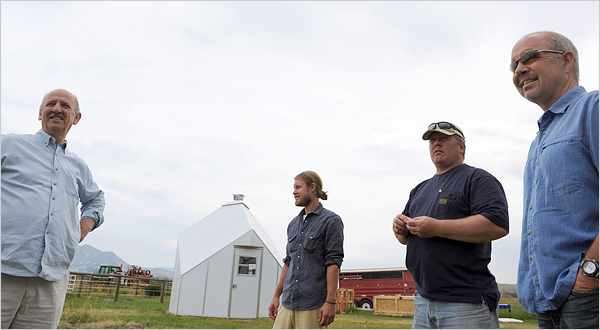A New York Times article tells about the Leeps, builders of luxury homes in Montana who when the economy turned bad began rethinking their business and are now building portable homes for disaster related areas.
For the Leeps and their partners, HabiHut is a strange new world. Money is the major difference — “We used to build houses that would buy a village for 20,000 people,” Mr. Weas said with a laugh —
Photo Credits: New York Times

Moreover, HabiHut has two dimensions. “It’s a project about providing shelter, but hopefully we can make money and create jobs,” said Mr. Weas, whose son Sean, a recent master’s graduate in architecture, is also involved in the venture. “The best of both worlds. There’s a moral aspect to it that wasn’t there at the Yellowstone Club.”
At a weight of around 400 pounds and before being assembled it will fit into a 4? by 8? crate for shipping. The tools needed are a screwdriver to put it together and it is rated to last about 15 years.
The first few dozen HabiHuts have been manufactured, with several in use in Kenya, two in Haiti and another 20 en route to Haiti for sale.
Read the complete article at the New York Times website and visit the HabiHuts website to learn how you can help get these to those in need.

The Habi-Huts are quite a nice design, but I really liked the (more permanent) Abod houses that were also talked about in that NYTimes article. They seem like the kind of place that I would be willing to live in long term. They are a nice compliment as quick build and longer term structures.
Cool, More info please. A post about this could include how much they cost, the square footage, the weight………….
How do they know there is not a domestic, money making market for these, if they don’t market them?
I like the look of this–and the price seems right for large scale use.
I wonder, too, if the shipping package (the white, rectangular box in the background at the end of the video, I assume?) could be made to hold water? If so, and if the run-off from the roof could be diverted into it, would that be of use?
Obviously, having water–to drink, wash, etc.–is good, but maybe it would clutter a refugee camp, or be a bone of contention as people used up their own and eyed each others’, or be a breeding ground for mosquitos, or not be maintained so as to be useful for drinking. Might get complicated, but the basic need for water makes it seem worth ironing out details.
I’m a teaching planning a student club focused on disaster preparation and response, so if anyone knows or has thoughts, I’d be particularly glad to hear them. I’ll check back to see if there are responses.
Ok, sorry. I took the link to the full story and that info was there. I would still like to know the foot print and weather or not you could fit a wood stove in it, or put the pipe through the roof with out melting it. what about ventilation?
They mention they are translucent on the site, providing light. They appear to be some sort of plastic sheeting. I would call these hard sided tents more then actual permanent habitats of any sort, making the cost astronomical for disaster use… Unless they are donating them, which it appears they are not.